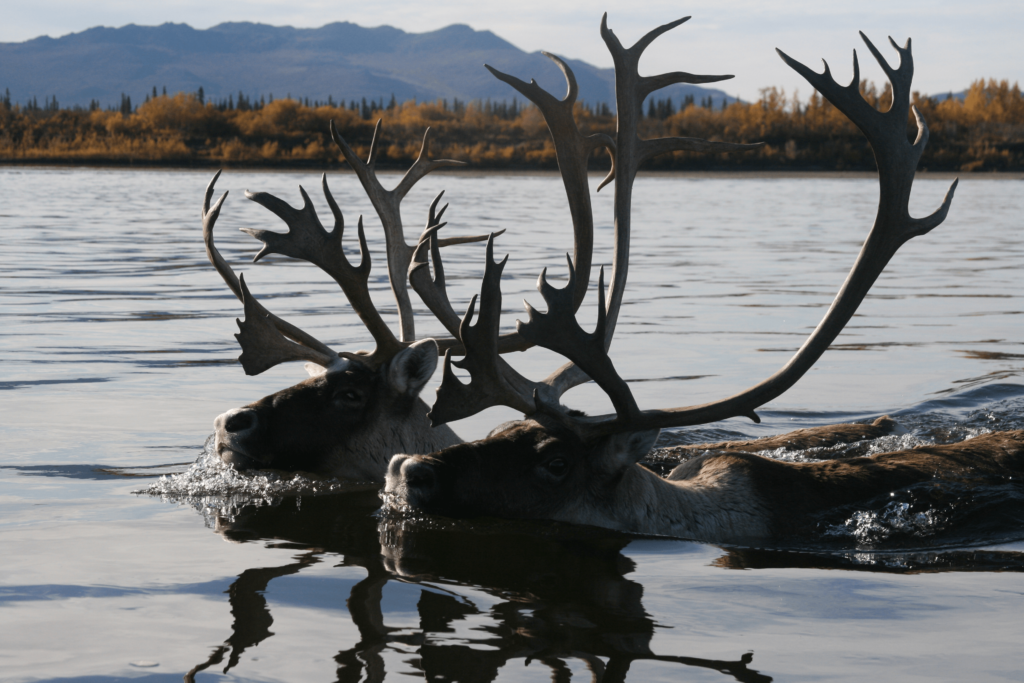The Ultimate Guide: Gates of the Artic National Park
Welcome to the Gates of the Artic National Park, one of the most remote and wild places in the United States. Located in the northernmost part of Alaska, this park offers visitors the chance to explore some of the most beautiful and pristine wilderness in the world. With 8.4 million acres of rugged mountains, pristine rivers, and diverse wildlife, the park is a true haven for adventure seekers and nature lovers. In this guide, we will take a closer look at the park’s history, main sections, essential information, best hikes, accommodations, safety and surrounding area. Whether you’re planning a trip to the Artic National Park or just want to learn more about this amazing place, this guide is for you.
For a condensed view of the park feel free to check out rvResortScouts Gates of the Artic National Park Information listing.
Note* This article will repeat several key points. This is one of the most rugged and isolated National Parks in America. Therefore, it is paramount that we stress safety and being prepared to take on the challenge.
Park History / General Overview
The park was established in 1980 and is managed by the National Park Service. And is known for its rich wildlife. This includes grizzly bears, wolves, caribou, moose, and Dall sheep. The park also has a rich cultural history, with the Inupiat people having lived in the area for thousands of years. Visitors can explore the park’s many trails and backcountry areas, take part in ranger-led activities, and learn about the park’s natural and cultural history.
The park’s name, “Gates of the Artic”, comes from the Brooks Range, a mountain range that runs through the park and forms a barrier between the Artic Ocean and the Interior. The park’s main attraction is its remote and wild nature and is a destination for backpackers, hikers, and other outdoor enthusiasts.
The park is open year-round; however, the best time to visit is during the summer months of June to August when the weather is milder and the days are longer. Visitors can access the park by small plane, bush plane or by hiking in. The park has no road access, no visitor center and no facilities; this makes it an ideal destination for people seeking wilderness experience.
Getting Oriented
The Gates of the Artic National Park is a large and remote wilderness area with no roads or established trails. The park is divided into two main sections: the Brooks Range and the Artic Plain.
The Brooks Range is the northernmost mountain range in North America and runs through the park. It is home to rugged peaks, glaciers, and abundant wildlife. The range is accessible by foot or by small plane and is popular with hikers and backpackers.
The Artic Plain is located to the north of the Brooks Range and is a vast and flat landscape. It is home to the nation’s largest population of caribou and is a popular destination for wildlife viewing. The plain is also home to the park’s Inupiat cultural sites and is accessible by foot or by small plane.
Visitors can also explore the park’s many rivers and streams, which offer excellent fishing and rafting opportunities. The park’s backcountry areas are also popular with visitors, offering a true wilderness experience.
It’s important to note that the park has no roads, no visitor center, and no facilities, this makes it a true wilderness destination. Visitors should come prepared with proper gear, supplies, and knowledge of survival skills. The park also has no marked trails, visitors should be familiar with navigation and wilderness survival skills. It is important to plan ahead and to be aware of the potential dangers before venturing into the park’s backcountry areas.
Gates of the Artic National Park Essentials
To fully experience the beauty of the park, visitors must take the necessary steps to prepare themselves. Here are some essential things to know before visiting the park:
Getting to the park: The park is located in the northernmost part of Alaska and can only be accessed by small plane, bush plane or by hiking in. Visitors can fly into the towns of Bettles, Coldfoot, or Anaktuvuk Pass, which are the closest communities to the park. From there, visitors can arrange for a bush plane or a chartered flight to take them deeper into the park.
Rules and Regulations: The park has strict rules and regulations in place to protect the park’s natural and cultural resources. Visitors must obtain a backcountry permit before entering the park’s wilderness areas. The park also has strict regulations regarding camping, hunting, and fishing. Visitors should familiarize themselves with the park’s rules and regulations before their trip.
Visitor Center: The park does not have a visitor center. Visitors should obtain information about the park from the National Park Service website or by contacting the park’s headquarters in Fairbanks, Alaska.
Gear and Supplies: Visitors should come prepared with proper gear and supplies. The park can have harsh and unpredictable weather. Visitors should have warm clothing, a good quality tent, a reliable water filter, and a means of communication such as a satellite phone. It is also important to have enough food and supplies for the duration of your trip.
Things You Need to Know
- What to Pack: Visitors should come prepared with proper gear and supplies. The park can have harsh and unpredictable weather, visitors should have warm clothing, a good quality tent, a reliable water filter, and a means of communication such as a satellite phone. It is also important to bring insect repellent, sunscreen, and a first aid kit.
- Amount of Food Needed: Visitors should bring enough food and supplies for the duration of their trip. The park has no facilities and visitors should be self-sufficient. It’s a good idea to bring high-energy foods such as granola bars, nuts, and dried fruits.
- Hiking Gear: Visitors should have proper hiking gear, such as a good quality backpack, hiking boots, and trekking poles. The park has no established trails and visitors should be familiar with navigation and wilderness survival skills.
- Animals In The Area: The park is home to a variety of wildlife, such as bears, wolves, moose, and caribou. Visitors should be aware of the potential dangers and take proper precautions. Visitors should also be respectful of the park’s wildlife and keep a safe distance.
- Cost of Trip: The park entrance is free. However, visitors will need to pay for the cost of transportation to and from the park, as well as the cost of camping and backcountry permits.
- Family Activities: This park is a rugged wilderness. Visitors should come prepared and be aware of the potential dangers.
- Conservation: The park is home to a wide variety of wildlife and plants; visitors should be respectful of the park’s natural resources and follow Leave No Trace principles. Visitors should also be aware of the park’s strict regulations regarding hunting, fishing and camping.
- RV Dos and Don’ts: Visitors should not bring RVs to the park and should instead focus on backpacking and camping.

Best Hikes Within Gates of The Artic National Park
There are no marked trails in Artic National Park. The park is mostly wilderness and is intended for experienced backcountry hikers and backpackers. Visitors must navigate using a map and compass and be prepared to improvise their route.
Nevertheless, there are some popular hiking spots within the park:
- Arrigetch Peaks: This hike offers spectacular views of the Arrigetch Peaks and the Alatna River Valley. The hike is challenging and requires a high level of fitness and navigation skills. It’s a good idea to bring a map and compass, as well as a satellite phone for emergencies.
- Alatna River: This hike takes visitors along the Alatna River, passing through scenic valleys and rugged mountains. The hike is moderate and is a great option for visitors looking for a more relaxed experience. It is important to be aware of the potential for wildlife encounters and bring bear spray.
- Anaktuvuk Pass: This hike takes visitors to the historic village of Anaktuvuk Pass, home to the Nunamiut Eskimo people. The hike is easy and offers visitors a chance to learn about the culture and history of the area. Visitors should be respectful of the village and its residents.
- The Hulahula River: This hike takes visitors along the Hulahula River, passing through lush tundra and rugged mountains. The hike is moderate and is a great option for visitors looking for a more relaxed experience. It is important to be aware of the potential for wildlife encounters and bring bear spray.
- The Kongakut River: This hike takes visitors along the Kongakut River, passing through scenic valleys and rugged mountains. The hike is challenging and requires a high level of fitness and navigation skills. It’s a good idea to bring a map and compass, as well as a satellite phone for emergencies.
Accommodations
Backcountry camping is the only form of accommodation available within the park. Visitors must obtain a permit and follow Leave No Trace principles. You should be aware that camping is only allowed in designated areas, and that there are no facilities or services within the park. Visitors should come prepared with all necessary gear and equipment.
Gates of the Artic National Park is a wilderness area and does not offer any developed accommodations. Visitors must come prepared for backcountry camping and be self-sufficient. Visitors should also be aware that camping is only allowed in designated areas, and that there are no facilities or services within the park. Guests of the park who are not comfortable with backcountry camping can find accommodation outside the park, but should be aware that availability may be limited and should book in advance.
Safety
- Weather: Visitors should be aware that weather in the Artic can be unpredictable and can change rapidly. Be ready for freezing temperatures and storms. Visitors should also be aware that snow can fall at any time of the year. Check the forecast before venturing out.
- Navigation: Visitors should be aware that there are no marked trails in the park and that navigation is done with a map and compass. Visitors should have a good understanding of navigation and be comfortable with orienteering. Visitors should also be aware that the park is remote and that help may not be readily available in case of an emergency.
- Wildlife: Visitors should be aware that the park is home to a variety of wildlife, including bears. Visitors should take necessary precautions to avoid encounters with bears and other wildlife. Visitors should also be aware that the park is home to other dangerous animals such as the moose and the caribou. Be prepared for encounters with these animals.
- Self-sufficiency: Visitors should be aware that there are no facilities or services within the park and that they must be self-sufficient. Visitors should come prepared with all necessary gear and equipment and be prepared to improvise in case of an emergency.
What’s In The Surrounding Area
Gates of the Artic National Park is located in a remote area of Alaska, but visitors can find a variety of services and activities in the surrounding towns of Coldfoot and Bettles. The Brooks Range and Koyukuk River are also nearby, offering visitors a variety of outdoor activities such as hiking, fishing, and hunting. The Artic National Wildlife Refuge is also located just south of the park and offers additional outdoor activities and adventures.
- Coldfoot: Coldfoot is a small town located about 100 miles south of the park. Visitors can find a variety of services here, including a gas station, a post office, and a visitor center. Coldfoot also offers a variety of accommodation options such as cabins, lodges and RV parks.
- Bettles: Bettles is a small town located about 100 miles west of the park. Visitors can find a variety of services here, including a gas station, a post office, and a visitor center. Bettles also offers a variety of accommodation options such as cabins, lodges and RV parks.
- Brooks Range: The Brooks Range is a mountain range that runs through the park and surrounding areas. Visitors can find a variety of outdoor activities in the Brooks Range such as hiking, fishing, and hunting.
- Koyukuk River: The Koyukuk River is a large river that runs through the park and surrounding areas. Visitors can find a variety of outdoor activities on the Koyukuk River such as rafting, fishing, and hunting.
- Artic National Wildlife Refuge: The Artic National Wildlife Refuge is located just south of the park and offers a variety of outdoor activities such as hiking, fishing, and hunting.
Gates of The Artic National Park Wrap Up
In conclusion, the National Park is a beautiful and unique destination for outdoor enthusiasts. The park offers a wide range of activities such as hiking, fishing, and hunting. Visitors can get oriented with the park by exploring the main sections of the park, such as the Brooks Range and Koyukuk River. To plan a visit, it is important to know the essentials such as the best time to go, how to get there, and what to bring. Visitors should also be aware of the park’s rules and regulations, as well as the best hikes to take. Accommodations include backcountry camping and nearby towns Coldfoot and Bettles offer a variety of services and accommodations.
Safety is important in the park and visitors should be prepared for the wilderness and the wildlife. Lastly, the surrounding area offers additional outdoor activities and adventures in the Artic National Wildlife Refuge. With all this in mind, Gates of the Artic National Park is a must-visit destination for those who are looking for a true wilderness experience.


